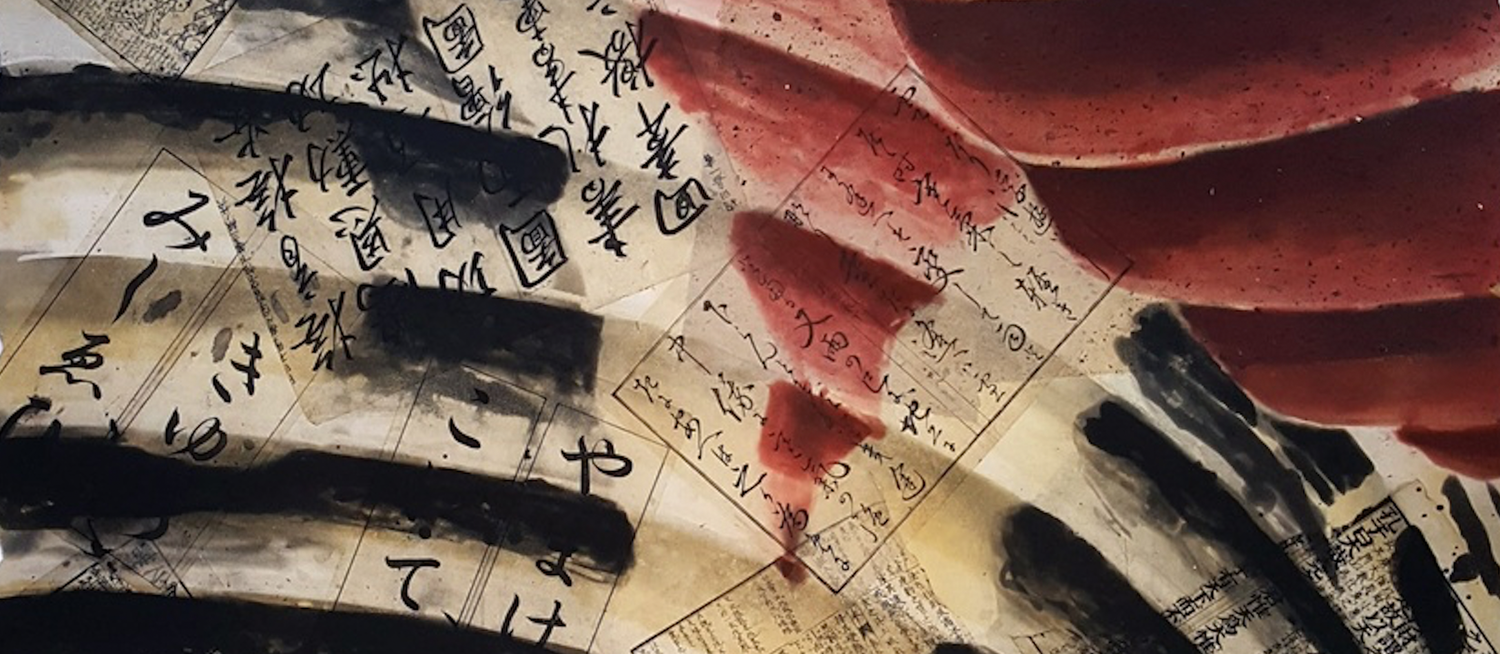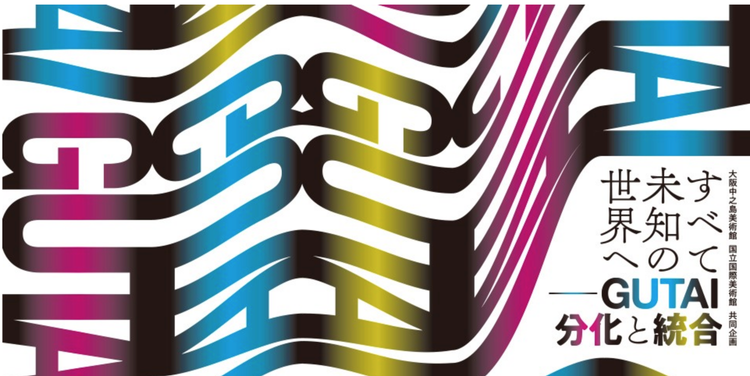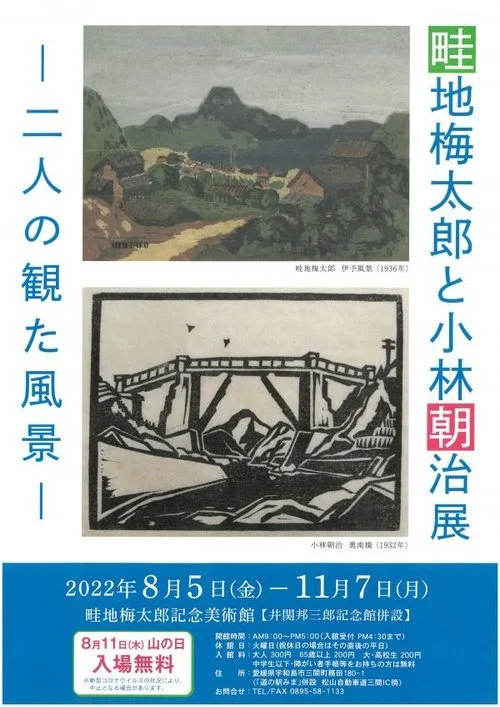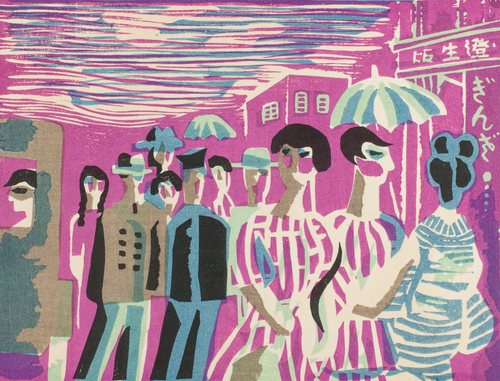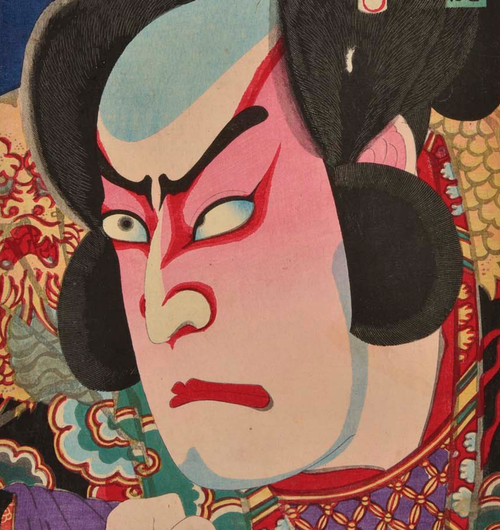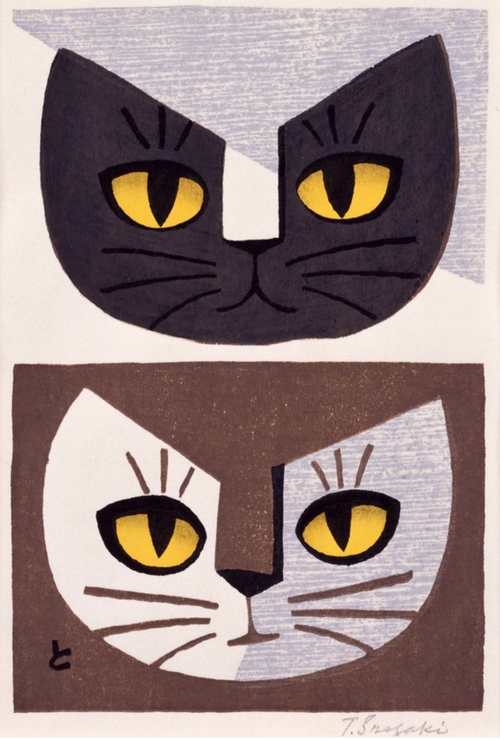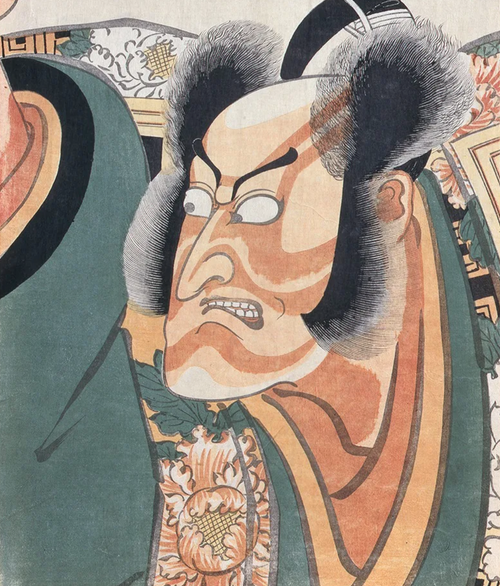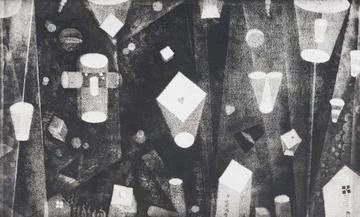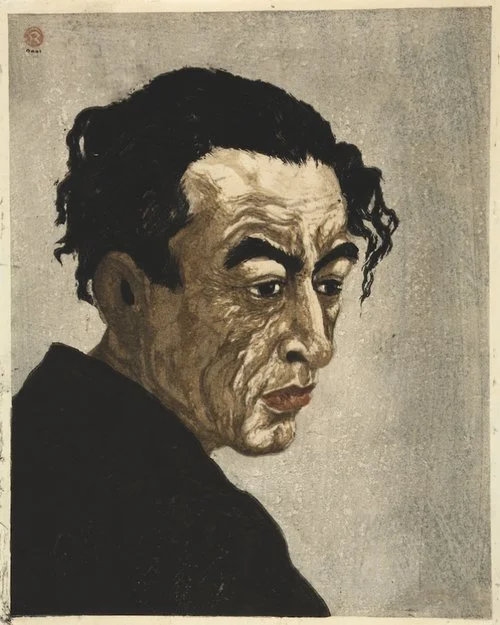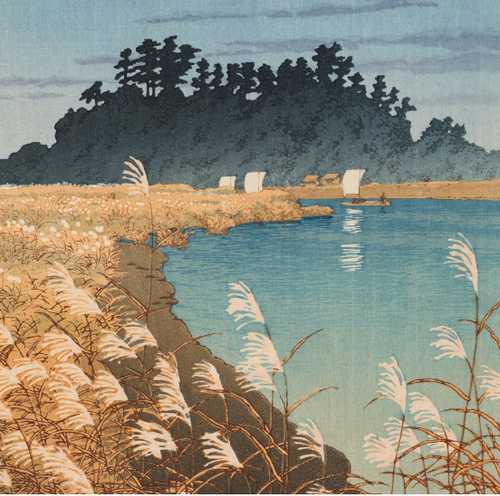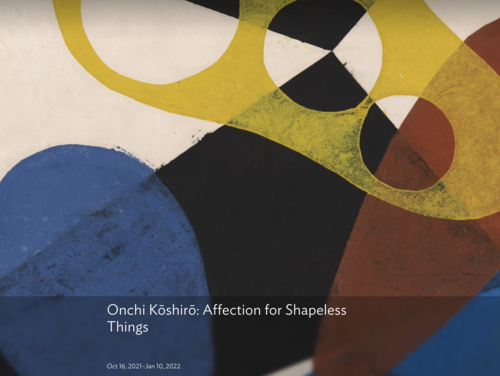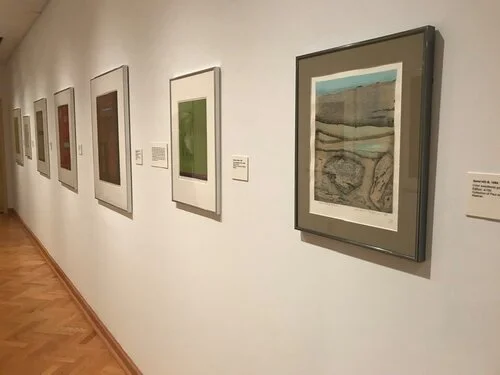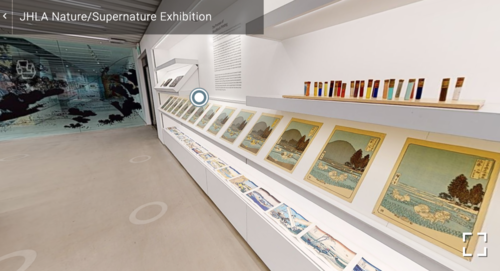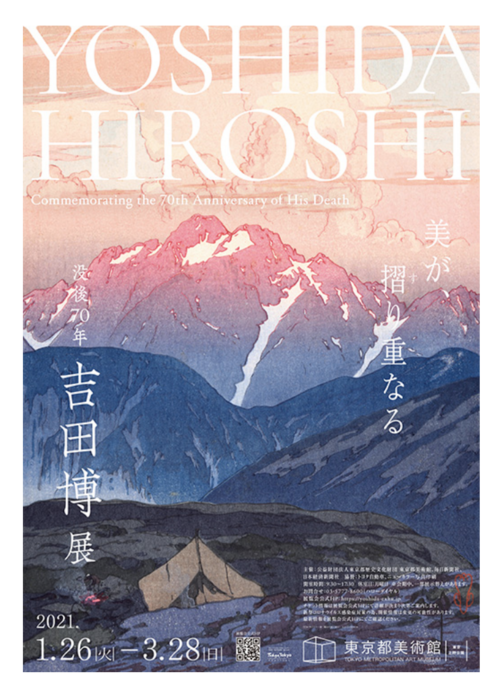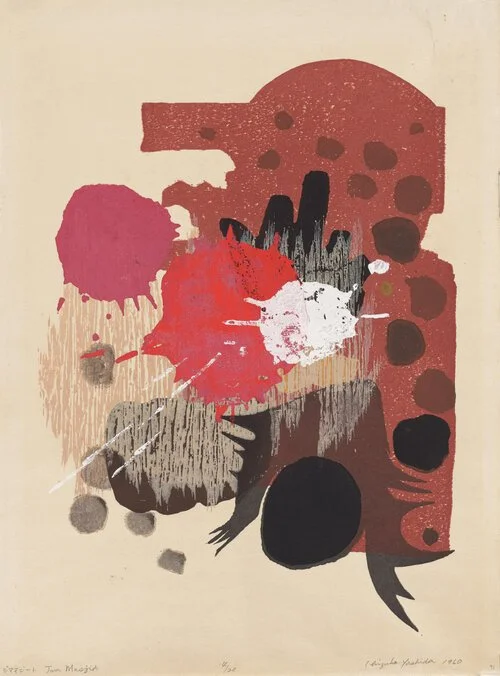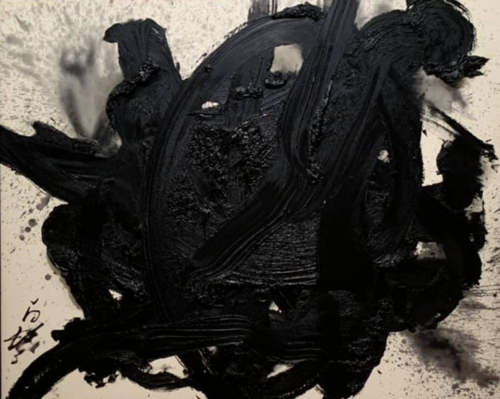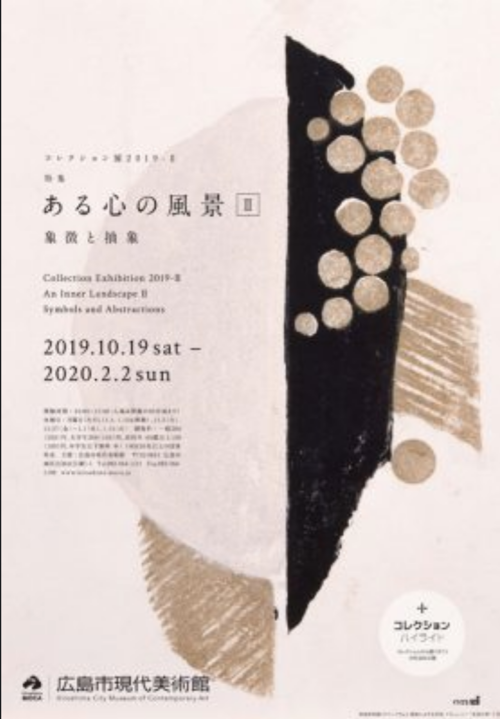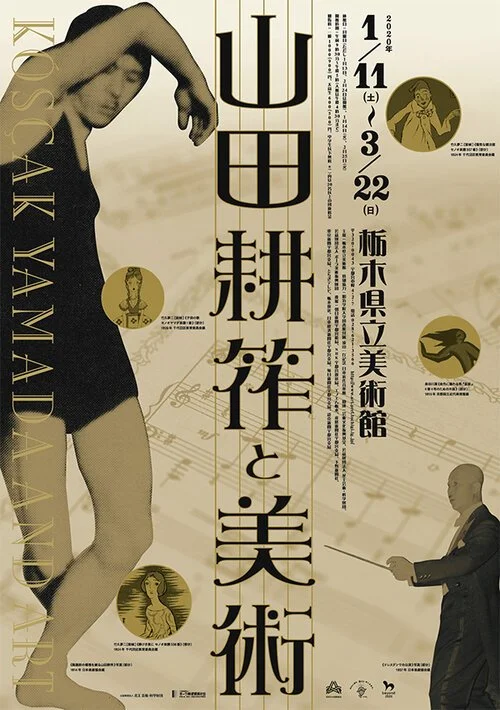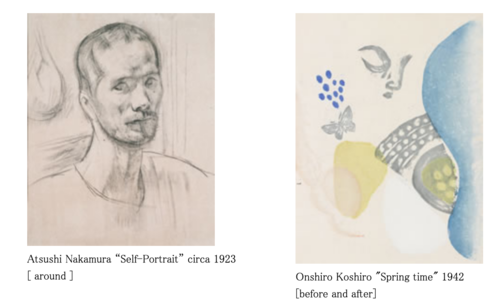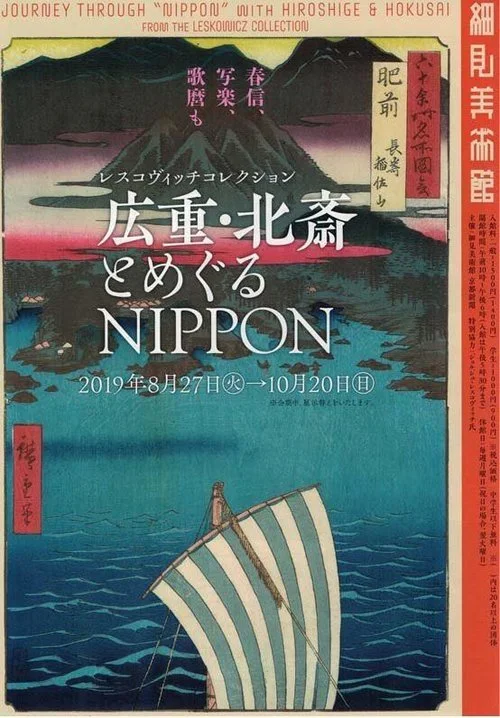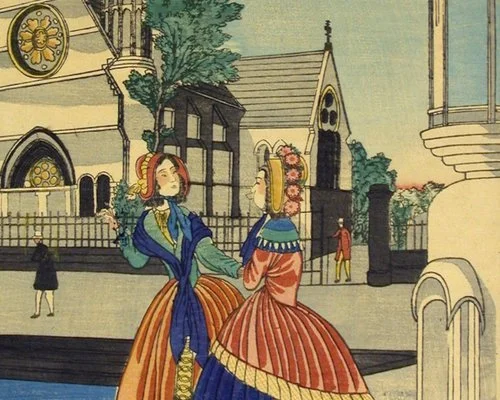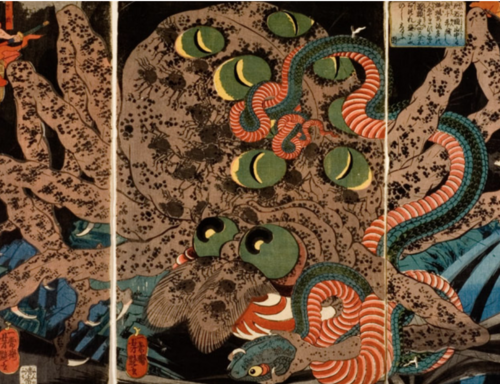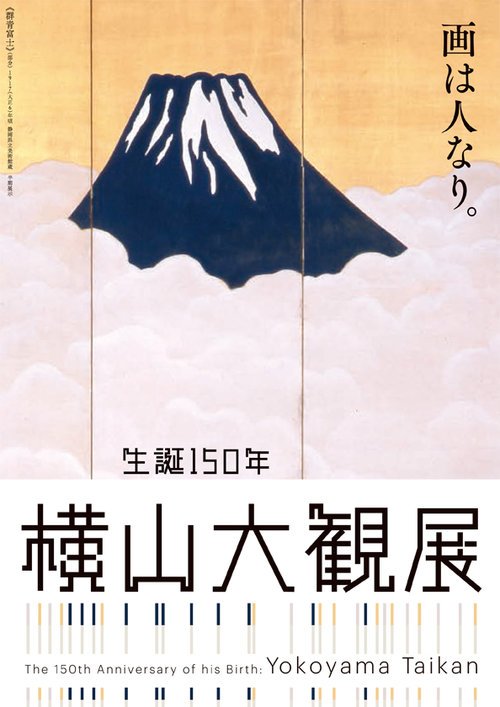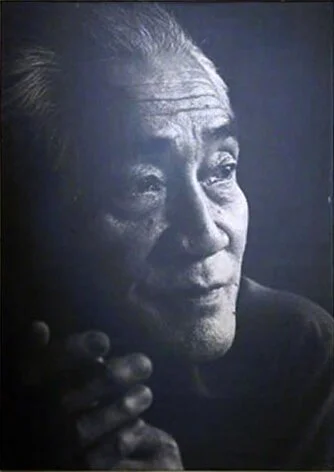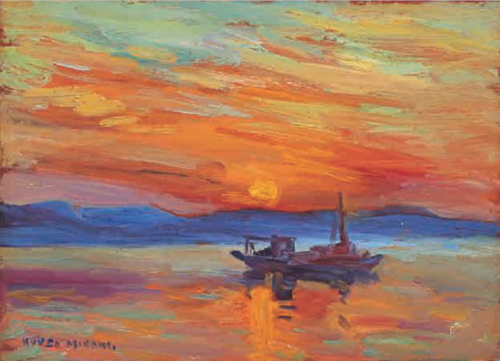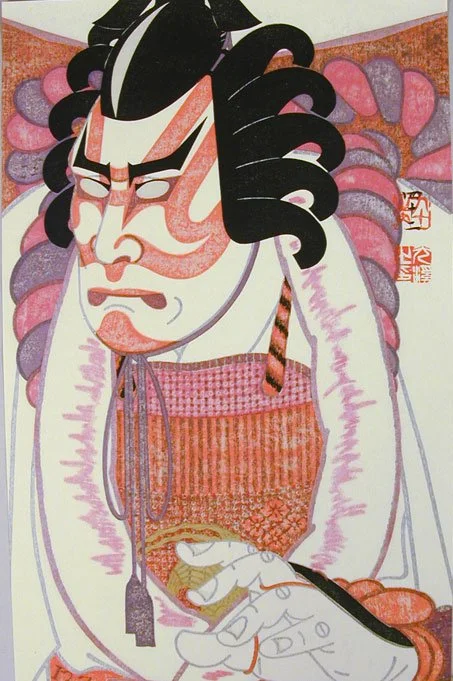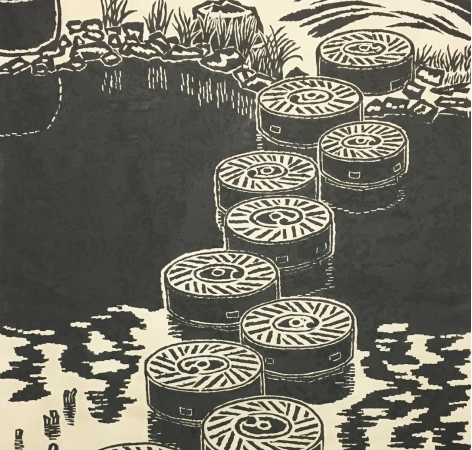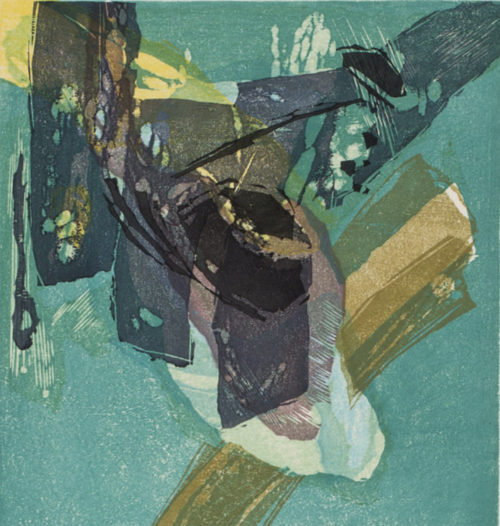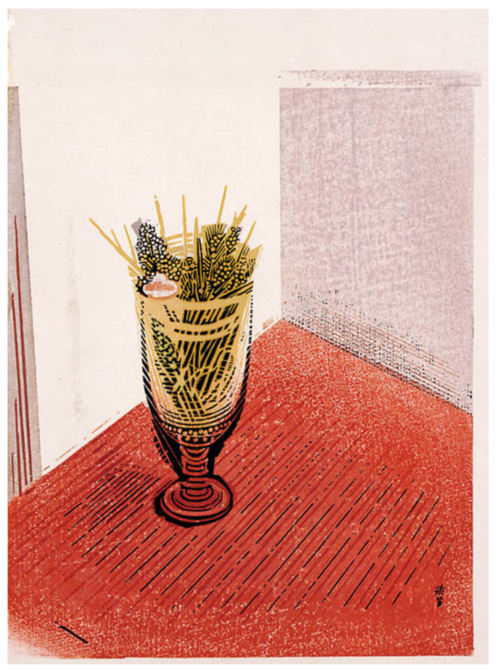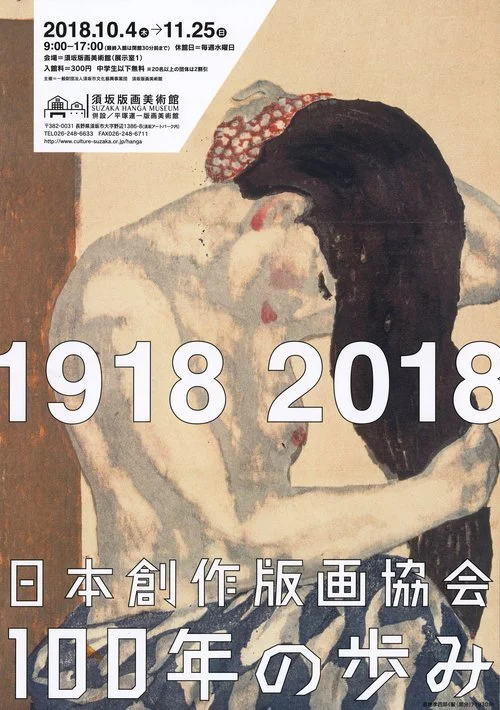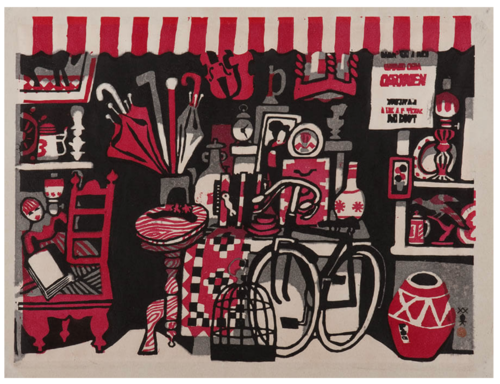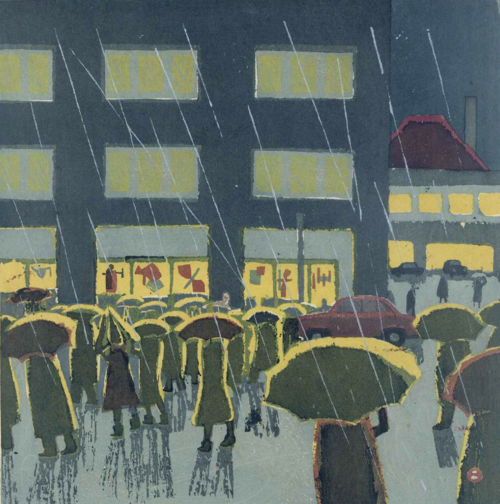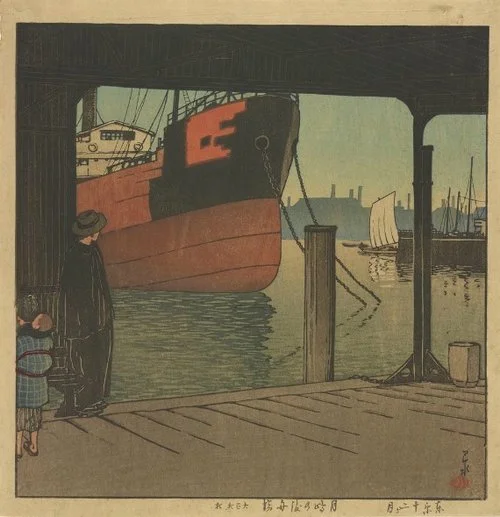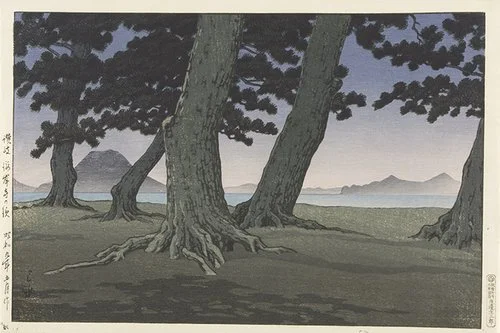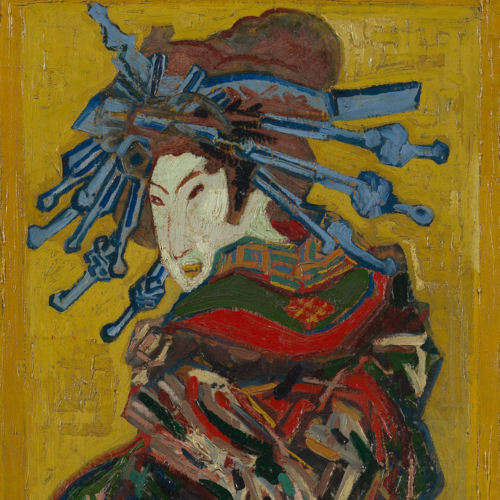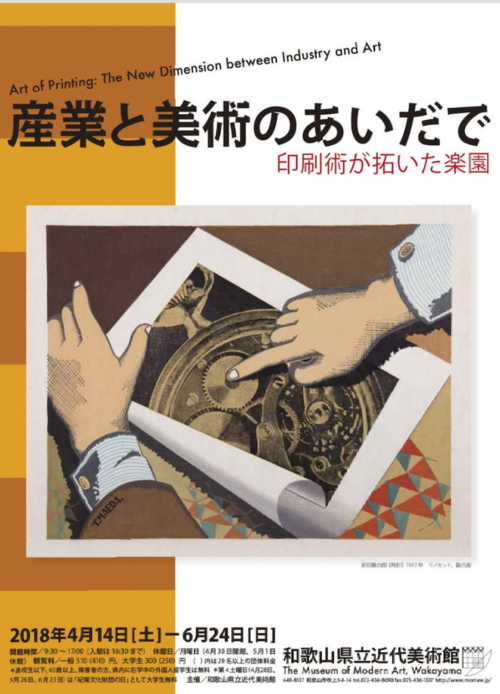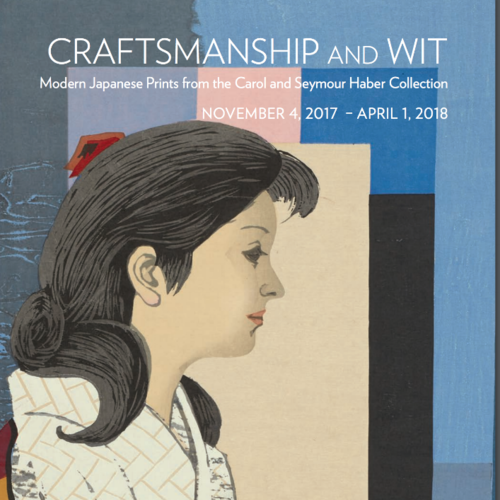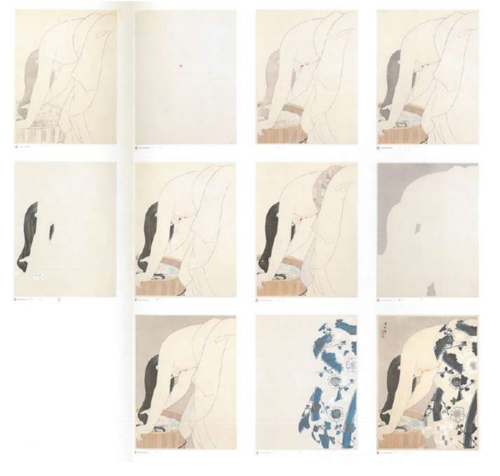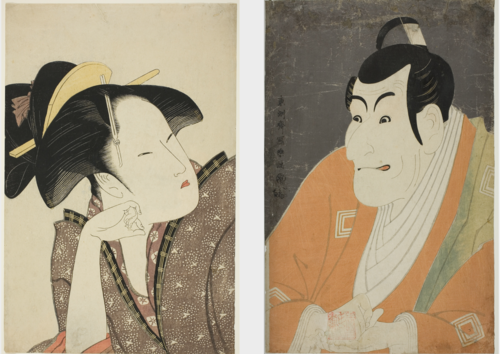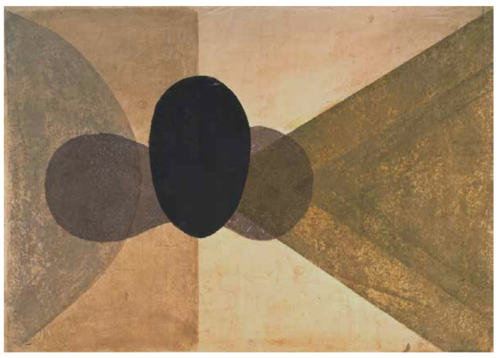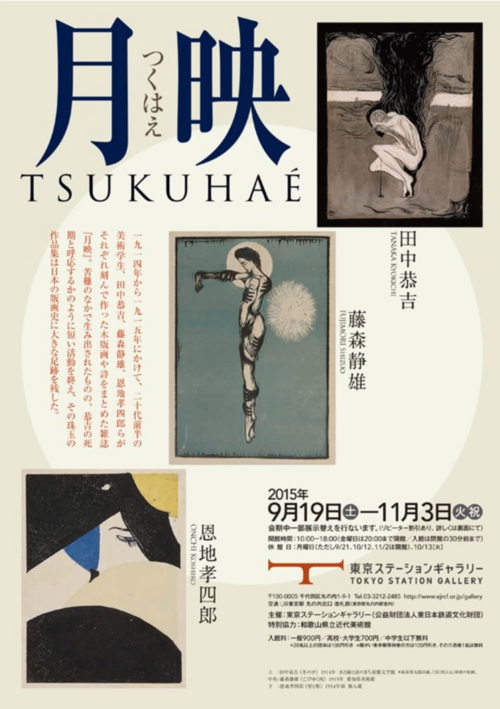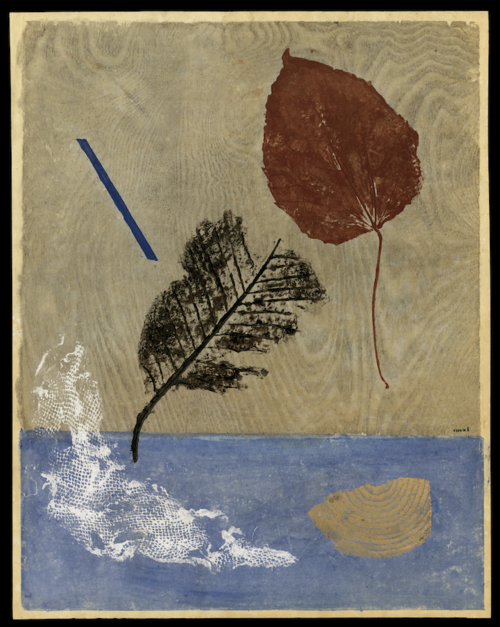NEWS
Stay connected to news world-wide on Japanese art and collecting. We regularly post information on museum exhibitions, seminars or sales. We are in the know and now you are too!
All to the unknown world ーGUTAI differentiation and integration
Gutai Art Association (Gutai)1954A group of artists formed in Ashiya, Hyogo Prefecture, in 1999. Painter Jiro Yoshihara (1905-72) at its core, this group sought to “concretely present proof that our minds are free” through various forms of practice, including painting. Members explored their originality under the guidance of Yoshihara18The trajectory of the years is now attracting a great deal of attention both at home and abroad, and has become partly mythical as one of the origins of postwar Japanese art.
This exhibition is an attempt to recapture these concrete steps from the two perspectives of "differentiation" and "integration." Yoshihara's attitude of trying to unite as a group while trying not to imitate anyone else and trying to be different from each other is Yoshihara's idea of what art should be. It can be said that it overlaps with the state of being.
Comprising two venues, the Nakanoshima Museum of Art, Osaka and the National Museum of Art, Osaka, this exhibition is the first large-scale Gutai exhibition to be held in Nakanoshima, Osaka, where Gutai Pinacotheca, Gutai Pinacotheca, was built. At the Nakanoshima Museum of Art, Osaka, Gutai is "differentiated" and the essence of each originality is explored, while at the National Museum of Art, Osaka, Gutai is "integrated" and the trajectory of the group's undulating quests is traced. The aim is nothing less than to present a new, concrete figure. After dissolution50be the year2022Please take a look at the history of them/them who pushed forward to "all unknown world" in 2018.
*This exhibition will be held at the Nakanoshima Museum of Art, Osaka and the National Museum of Art, Osaka.
This exhibition runs from 10-22-22 through 1-9-23.
Learn MoreUmetaro Azechi and Asaji Kobayashi: What they saw
Umetaro Azechi is a printmaker from Mima-cho, Uwajima City. After moving to Tokyo, he encountered printmaking techniques and established his own unique style through interaction with up-and-coming printmakers such as Unichi Hiratsuka, Koshiro Onchi, and Chiho Maekawa. He was popular as a ``mountain printmaker'' with the theme of mountains and mountain men, and was active in a wide range of activities internationally. The works of Umetaro, who cherished nature and loved the mountains, evoke a sense of warmth and generosity.
Asaji Kobayashi was born in Suzaka City, Nagano Prefecture. He was appointed as the first director of ophthalmology at the current Yoshida Hospital, and worked there for four and a half years. He started painting when he was a student, and while working as a medical doctor in Yoshida Town, he painted oil paintings and toured various parts of the town, and also engaged in various cultural activities. After that, his encounter with Umetaro led him to start woodblock printing. Asahji's oil paintings and prints, which loved the scenery of Yoshida-cho and valued the connection with people, express the scenery of Yoshida-cho in the early Showa era with a sense of taste.
In this exhibition, we will look back on the two artists' careers from the time they first met to the time they met, with a focus on oil paintings and prints.
This exhibition runs from 8-5-22 through 11-7-22
Learn MoreRecollections of Tokyo 1923-1945 at the Art Institute of Chicago
In 1923, Tokyo was devastated by the Great Kantō earthquake. Despite the destruction caused by this natural disaster, the city developed at an astounding rate over the next few decades. During this period, a number of printmakers documented their impressions of the city’s ruin and rebirth.
While some of these prints depict the remnants of destroyed buildings, many more show people enjoying the city’s new developments, from the bustling Ginza shopping district to the fashionable cafés of Shinjuku. This modern urban landscape became a favorite subject for artists such as Oda Kazuma (1882–1956), a lithographer who portrayed Tokyo’s crowded streets and nighttime attractions.
The allure of Great Tokyo, as it came to be called, would be short-lived. The area was firebombed by Allied forces during World War II, causing another round of devastation. The prints made in the period between the earthquake and World War II thus became a kind of time capsule. In 1945, some artists were prompted to reissue their scenes of urban life, along with new prints that were similarly nostalgic; this expanded series was called Recollections of Tokyo and the complete series is on view in this exhibition. A number of the scenes featured in these prints are recognizable today, including views of Tokyo Station, Ueno Zoo, and the bars and clubs of Shinjuku. Taken together, such representations of forgotten or lost places and buildings remind us of time’s passage and the ever-changing nature of a dynamic urban metropolis.
This exhibition runs from 7-2-22 through 9-25-22
Learn MoreKunichika: Japanese Prints is at the Lady Lever Art Gallery
Toyohara Kunichika is today considered to be one of the most important 19th century print makers in Japan. His woodblock printing continued a traditional form of Japanese printmaking whilst subtly chronicling the country’s move towards modernity in the nineteenth century.
His prints evoke many things – from the centuries-old traditional theatre of Japan to Manga to traditional Japanese notions of female beauty – but mostly they conjure the colour and drama of kabuki, a classical form of Japanese dance-drama renowned for its flamboyant costumes and highly elaborate kumadori make-up.
A bawdy mixture of theatre, mime and dance, kabuki originated at the beginning of the Edo period (1603 – 1867), a time of stability, peace and unification that followed centuries of civil war. It was also a period that saw the arts and culture flourish, especially in the emerging new capital of Edo.
Sixty-eight of his hand-printed single, double and triptych prints feature in the exhibition and include behind-the-scenes dressing room views, on-stage dramatic moments and close-up actor portraits, as well as ten prints selected from his various series of ‘female beauties’, known as bijinga, which were enormously popular in the increasingly worldly culture of Edo.
A number of the prints also capture contemporary kabuki plays that highlighted up-to the-minute issues like Western clothing, hairstyles, fashions and manners. They also explore the troubling social anxieties and conflict between the old versus the new in the rapidly modernising capital city.
The exhibition also highlights a tangential but fascinating connection between Kunichika and another famous artist of late 19th century Europe, Vincent Van Gogh.
This exhibition runs through 9-4-22
Learn MoreMoga: Modern Women & Daughters in 1930s Japan
This intimate exhibition of paintings explores the depiction of the urbane “modern girl” (modan gāru or moga), which captivated public imagination in 1920s Japan and challenged the traditional, state-sanctioned ideal of the “good wife, wise mother.” Indeed, the ideal role of women in Japanese society was not one-dimensional, and continued to diversify during the 1930s. Moga: Modern Women and Daughters in 1930s Japan brings traditional subjects, including domestic scenes representing mothers and daughters, back into the conversation about the moga by exhibiting them beside other, more popular imagery of the “modern girl.”
Many of the paintings in the exhibition—all of which are drawn from the private collection of Naomi Pollock and David Sneider—originated in the noted Meguro Gajoen, currently Hotel Gajoen Tokyo (ホテル雅叙園東京), a massive entertainment complex first opened in 1931, filled with paintings from the period—primarily of women.
The founder of the Meguro Gajoen, Hosokawa Rikizō, was a great patron of new Japanese-style paintings (shin nihonga), which blended Western motifs and perspective techniques with traditional Japanese painting materials and methods. He collected many notable artists from the Shōwa Era, as well as works reflective of the period’s popular taste.
Both modern in appearance and traditional in values, these works from the walls of the Meguro Gajoen featured women and children engaged in scenes from everyday life. Such paintings have received less attention than those of the typical, progressive moga, which have tended to be the primary focus of past museum exhibitions and academic narratives. Moga: Modern Women & Daughters in 1930s Japan is a nuanced exploration of feminine representation during a period of dramatic change.
This exhibition runs from 5-6-22 through 7-30-22
Learn MoreCats in Tokyo
The Meguro Museum of Art opened 35 years ago in 1987 as the seventh art museum in Tokyo. Since 2018, 11 ward art museums in Tokyo have gathered to continue their collaborative activities as the "Tokyo/Municipal Art Museum Network." So far, we have jointly created leaflets introducing the activities of each museum, held discussion events, and exchanged information. This time, works depicting cats from 10 museums with collections participating in this network will be gathered at the Meguro Museum of Art. The cats that are the pride of each museum are not only cute, but also present the meaning of the artist's drawing of cats. Cats are a motif that can express delicate fur for painters and supple body lines for sculptors. Also, for many artists, cats are objects of admiration and sympathy as free existences that are not bound by society. Cats have long been associated with the theme of the brave "tiger", and this year 2022 is also the year of the tiger. Cats are familiar and familiar, but the actual works you see reflect the characteristics of each museum's collection. Through the exhibition, we will also introduce the various activities of Tokyo's municipal art museums.
Many of the paintings in the exhibition—all of which are drawn from the private collection of Naomi Pollock and David Sneider—originated in the noted Meguro Gajoen, currently Hotel Gajoen Tokyo (ホテル雅叙園東京), a massive entertainment complex first opened in 1931, filled with paintings from the period—primarily of women.
This exhibition runs from 5-14-22 through 6-5-22
Learn MoreIki and Gloss— Top Stars of Edo
The MOA, Museum of Art in Atami, Shizuoka, will feature a selection of portraits of actors and courtesans. The exhibition will showcase prints with a keen sense of fashion.
This exhibition runs from 4-23-22 through 6-8-22
Learn MoreShin Hanga: The New Prints of Japan 1900-1960
With a unique selection of over 200 Japanese colour woodblock prints from the first half of the 20th century, the exhibition shows the development of shin hanga (‘new prints’). The subjects range from female beauties and great actors of the kabuki theatre to atmospheric landscapes and impressive depictions of birds to scenes from modern urban life.
Works by all the major shin hanga artists will be represented, depictions of "beautiful women" by the artists Hashiguchi Goyō, Torii Kotondo and Itō Shinsui or the impressive landscapes by the famous Kawase Hasui. It is not so much in their subject matter as through their visual language that shin hanga prints set themselves apart from their traditional precursors.
The woodcuts selected for the exhibition come from two major Dutch private collections and from the family collection of Watanabe Shōzaburō, the most important publisher of Japanese prints of the 20th century. The selection is enriched by a newly acquired spectacular pair of folding screens by the painter and shin hanga artist Yoshida Hiroshi (1876–1950).
This exhibition runs from 03-11-22 through 06-06-22
Learn MoreUnderdogs and Antiheroes: Japanese Prints from the Moskowitz Collection
Expect the unexpected. The exhibition Underdogs and Antiheroes: Japanese Prints from the Moskowitz Collection focuses on the captivating stories and urban legends of individuals living on the fringes of society in early modern Japan. Key subjects in theater, literature, and visual arts reveal antiheroes and underdogs whose virtues are often embodied by their rejection of societal norms, making them misfits and moral exemplars at the same time. The exhibition will follow virtuous bandits, tattooed firemen who love to fight, rogues from the kabuki theater, and others.
Highlighting the transformative gift of the Pearl and Seymour Moskowitz Collection to the National Museum of Asian Art, Underdogs and Antiheroes features subjects that are not commonly associated with traditional Japanese print culture but were nevertheless central to the interests of an early modern public. The exhibition will explore new visual and thematic ground, further strengthening the museum’s trailblazing role in reconsidering presentations of Asian cultures.
This exhibition runs from 03-19-22 through 01-29-23
Learn MoreVISION OF A MOMENT: JAPANESE PRINTS 1950–1960
In 1961 the Japanese government presented the Ashmolean Museum with a set of forty works by Japan’s leading contemporary print artists. The gift was part of a cultural exchange between the UK and Japan, and also celebrated the establishment of a new Eastern Art Department in the museum.
This exhibition commemorates the 60th anniversary of this extraordinary gift and of the founding of the Eastern Art Department. It includes a range of abstract and figurative works, including woodblock prints, mezzotints and lithographs – all examples of sōsaku hanga ‘Creative Prints’, made by artists who embraced modernist ideals of artistic self-expression.
While Creative Print artists had begun transforming Japanese printmaking in the first decades of the twentieth century, it was in the 1950s that they first achieved widespread international acclaim. ‘Vision of a Moment’ presents a snapshot of the art of Japanese printmaking at this golden moment in its history.
This exhibition runs through 09-18-22
Learn MoreRepro Japan: Technologies of Popular Visual Culture
In Japan’s Edo period (1603–1868), the growth of urban audiences and new popular entertainments from kabuki theater to travel tourism developed in tandem with new printing technologies. This resulted in the rise of new forms of visual culture—including color woodblock prints and printed textiles—that could be mass produced, transformed, and consumed.
Subsequently, photography and electronic media have fostered the global spread of Japanese popular visual culture, including manga, anime, cosplay, and subcultural fashion. This spread across different technologies, eras, and cultures has produced an incredible diversity of material—reproductions, appropriations, reverse-importations, parodies, remixes, and tributes. At the same time, the central themes and motifs—sports, fashion, and fighting, along with fantasies of all kinds—have remained remarkably consistent.
These themes and media technologies are integrally linked with the human body: as subject, maker, performer, viewer, and consumer. Bodies represented in 18th-century prints, 19th-century photographs, and 20th-century anime cels are seen taking similar actions, from gazing in mirrors to exchanging blows. These bodies can be read variously as objectified or self-actualized; as violated, celebrated, or liberated; as objects of pure, popular consumption or as nuanced critiques of consumption itself.
This exhibition runs from 10-1-21 through 03-19-22
Learn More Exhibition PublicationSōsaku hanga. Creative print art from Japan
Japan Museum SieboldHuis is pleased to present ‘Sōsaku hanga. Creative print art from Japan. From 17 December 2021 to 13 March 2022 over 140 works of the sōsaku hanga movement will be on display showcasing the creative autonomy of the Japanese print artists. ‘Sōsaku hanga’ is a must see exhibition for lovers of traditional Japanese prints and connoisseurs of modern art.
‘Sōsaku hanga’ presents a chronological overview of the development of the creative print art in 20th century Japan in over 140 works of the most important sōsaku hanga-artists. All works are from Nihon no hanga collection. This is part one of a two-part exhibition. Part two will highlight ‘shin hanga’ (new print art) with works from collections from home and abroad.
This exhibition runs from 12-17-21 through 03-13-22
Learn MoreShiko Munakata: A Way of Seeing
This new presentation of nearly 100 path-breaking works by celebrated artist Shikō Munakata (1903-1975) is organized from Japan Society’s rare collection—the largest Munakata collection in the United States. Primarily known for his powerfully expressive woodblock prints, this exhibition reveals the breadth of Munakata’s oeuvre, which spanned from prints to calligraphy, sumi ink paintings, watercolors, lithography, and ceramics.
With his bold, spontaneous, and sketch-like lines, Munakata developed an innovative style that revolutionized the woodblock print. A highlight of the installation is his complete Tōkaidō Series (1964), a set of 61 newly rediscovered prints that depict scenes the artist witnessed while traveling along the vital coastal route between Tokyo and Kyoto, which Munakata extended to Osaka. This full set will be on view for the first time since 1965.
No matter the medium, Munakata’s artistic explorations were characterized by a spirited curiosity and relentless experimentation. Munakata incorporated diverse sources and inspiration in his dynamic works, including Japanese folk tales, Buddhism, Western literature and poetry, and nature motifs, represented by works in the exhibition. The exhibition underscores Munakata’s first visit to the United States in 1959 as a Fellow in Japan Society’s Print Artists Program, and includes works he made expressly for Japan Society during his time in New York.
This exhibition runs from 12-10-21 through 03-20-22
Learn MoreCompeting Currents: 20th-Century Japanese Prints
Japan’s printmaking landscape underwent an unprecedented tidal shift in the twentieth century. During the Edo period (1603–1867) a new market of middle-class patrons had encouraged artists to create expressive and iconic images for mass distribution. These prints, known as ukiyo-e (pictures of the floating world), became wildly popular not only in Japan but across the globe when the country opened to international trade in the mid-nineteenth century. By the beginning of the twentieth century, however, woodblock prints had largely fallen out of vogue. Mass-market newspapers and magazines had taken Japan by storm, and the popular woodblock prints of the previous century seemed to many a relic of the past.
Despite these shifts, two movements reinvigorated the public’s relationship with printmaking in both Japan and the West: shin-hanga (new prints) and sōsaku-hanga (creative prints). The former was defined by a nostalgia for the premodern while the latter, rejecting the past entirely, embraced modernist and avant-garde sensibilities. In both movements, however, printmakers were forced to reckon with the legacy of ukiyo-e, new influences from European art, and the demands of a rapidly evolving global market. Simultaneously, a complete overhaul of Japan’s public infrastructure, two world wars, and a series of cataclysmic natural disasters continually disrupted artistic pursuits.
Following differing politics and aesthetic ideals, twentieth-century Japanese printmakers responded to these events in varied and industrious ways, a fact reflected in the heterogeneity of their compositions. Though shin-hanga and sōsaku-hanga represent only a small part of a complicated evolution, these works provide a glimpse of the contested artistic currents that defined Japanese printmaking in the twentieth century.
This exhibition runs through 01-30-22
Learn MoreOnchi Koshiro: Affection for Shapeless Things
Onchi Kōshirō is emblematic of the midcentury sōsaku hanga, or creative print, movement in Japan as one of its major artists and its main advocate.
Artists of this self-defined group proudly conceived, carved, and printed their own works. They did not feel that the traditional ukiyo-e method, in which the tasks of designing, carving, and printing were separated among specialists, allowed for true creative expression. Onchi, who often cited Kandinsky and Munch as his major influences, was decidedly Western-oriented in terms of style. He explained that printmaking is the best way to create abstract art, since it is the most removed from the artist’s hand or brush and requires precision and forethought in construction and composition. In addition to wood, Onchi used wax paper, cardboard, string, and other found materials as his printing blocks.
It was common for Onchi to produce very few prints—often only a single edition of each of the abstract works that were the major output of his last 10 years. Very few of his works remain in private hands, and in terms of museums, the Art Institute of Chicago is one of only a few with significant holdings, thanks to gifts from key donors. Oliver Statler, an army employee in Japan during the Occupation, was a great friend of Onchi’s and proponent of the sōsaku hanga movement. He gave a large portion of his personal collection to the Art Institute and was also the intermediary in sales of his works to local collectors. In turn, these collectors gave their Japanese modern prints to the museum, including many of the works on display in this exhibition.
This exhibition runs from 10-16-21 through 01-10-22
Learn MoreKawase Hasui: Travel and Nostalgic Landscape
A retrospective exhibition of the woodblock print artist Hasui Kawase (1883-1957), who was active during the Taisho and Showa eras. Hasui was inspired by breezes, and spent his days travelling with the sun, clouds, and rain, painting the scenery of all four seasons of Japan. This was also a journey to seek the scenery of old times. One of the key supporters of woodblock production was Shozaburo Watanabe, a woodblock print publisher and leader of the shin-hanga (new prints) movement. Their strong desire to create something special lead them to strive for woodblock prints that could also be appreciated overseas. Hasui’s landscape prints are admired for their soothing effects. This exhibition invites you to the world of Hasui, and consists of valuable works including some series that can rarely be seen together. This group of prints rich in poetic sentiment, and which makes full use of traditional woodblock printing skills, offers a moment of calm in a bustling city.
This exhibition runs from 10-02-21 through 12-26-21
Learn More Review of ExhibitionTajima In Relief: A Retrospective of the Artist's Relief Prints
TAJIMA IN RELIEF is the first major museum retrospective of relief prints by Tajima Hiroyuki (1911-1997), a Japanese artist internationally renowned for his use of layered and luminous color and his complex and creative printmaking techniques. Featuring more than 60 prints made over the course of his career, it examines Tajima’s recurring themes and his approach to abstraction. Tajima exemplifies the inventive incorporation of international trends that characterizes post-WWII Japanese printmaking.
Tajima Hiroyuki trained as an artist at Nihon University, graduating in 1932, and the Western Painting division of Tokyo’s School of Fine Arts. In 1946 he joined Bijutsu Bunka Kiyokai, a group of artists engaged in revitalizing Japanese abstract and surrealist painting after WWII. Tajima not only embraced surrealism as an avant-garde mode of abstraction, but also incorporated technical studies in fabric dyeing and color photographic processes into his sosaku hanga (“creative prints” in which the printmaker is sole creator, serving as designer, block cutter, and printer).
The U.S. occupation of Japan after WWII provided a receptive audience for sosaku hanga and contributed to its international success. From the 1960s to the 1980s, Tajima won widespread acclaim for his abstract woodblock prints, whose experimental techniques created a thoroughly modern idiom while remaining in dialogue with traditional Japanese arts.
This exhibition runs from 09-24-21 through 12-11-21
Learn More Video of ExhibitionDoshun Mori Exhibition
On the occasion of the 35th anniversary of the death of Doshun Mori, a famous printmaker in Ibaraki, the exhibition will focus on work and materials donated by his family in recent years.
This exhibition runs from 07-27-21 through 11-22-21
Learn MorePrints, Ceramics, and Glass from Japan at the Ringling Museum of Art
CONTEMPORARY CERAMICS AND GLASS
Featuring artworks by Fujikasa Satoko (b. 1980), Miyashita Zenji (1939–2012), Niisato Akio (b. 1977), and Ikuta Niyoko (1953), this exhibition testifies to the technical finesse and imaginative spirit that make glass art and ceramics robust and dynamic fields. The Ringling is grateful to lenders Carol and Jeffrey Horvitz and the donors that have built The Ringling’s collection in these media.
ABSTRACT IMPRESSIONS
The exhibition includes pioneering artists such as Iwami Reika (1927–2020) who found new possibilities in Geometric Abstraction, while others, like her contemporary Shinoda Tōkō (1913–2021) were stimulated by Abstract Expressionism. These movements were themselves the products of decades of cross-cultural dialog; for example, the emphasis on calligraphic brushstrokes and spontaneous gesture in the latter was informed, although often unacknowledged, by the work of avant-garde calligraphers and popular discourse on Zen Buddhism.
The U.S. occupation of Japan after WWII provided a receptive audience for sosaku hanga and contributed to its international success. From the 1960s to the 1980s, Tajima won widespread acclaim for his abstract woodblock prints, whose experimental techniques created a thoroughly modern idiom while remaining in dialogue with traditional Japanese arts.
Japanese artists’ approaches to abstraction also emerged from explorations of their media, whether it be woodblock printing — a process perfected in 18th century Japan — or newer technologies, such as lithography. The materials and methods of printmaking are ideally suited to producing masses of flat color and texture, such as the woodgrain patterns of Hoshi Jōichi’s (1913–1979) abstract compositions. Decorative exuberance, such as the metallic finishes, rich pigments, and textured surfaces in Tamekane Yoshikatsu’s (b. 1959) prints, pay tribute to sophisticated precedents to modern abstraction, such as Japan’s Rinpa school (flourished 17–19th c.).
Drawing from The Ringling’s collection and loans from Christine and Paul Meehan and Daphne Rosenzweig, Abstract Impressions introduces some of Japan’s most innovative printmakers active between the 1950s and the present.
This exhibition runs from 8-15-21 through 01-16-22
Learn More Video of ExhibitionKiyoshi Saito Graphic Awakening
Saito Kiyoshi’s (1907–1997) keen sense of design, superb technique and engagement with an appealing variety of themes made him one of the best known and most popular Japanese print artists of the twentieth century.
In the wake of the Second World War, Saitō emerged as a seminal figure of the modernist creative print movement, in which artists claimed complete authorship of their work by carving and printing their own designs. He flourished as the movement attracted patrons among members of the occupying forces and, later, Western travelers for business and pleasure. Honors at the 1951 São Paulo Biennial launched him and the creative print movement to prominence at home and abroad. When new diplomatic ties between the U.S. and Japan provided opportunities for Japanese artists to exhibit, teach, and live abroad, Saitō was among the first to do so, thus further broadening his audience.
Presenting recent donations of artworks by Saitō from Charles and Robyn Citrin to The Ringling and other collections, Saitō Kiyoshi: Graphic Awakening is the first comprehensive exhibition of this artist’s work in the United States. The exhibition focuses on prints Saitō created in the 1940s and 50s, arguably the most vibrant period of his career, and includes several rare, early designs.
The exhibition is accompanied by a 200-page illustrated catalogue edited by Rhiannon Paget and with essays by Paul Binnie, Noriko Kuwahara, Rhiannon Paget, and Judith A. Stubbs, and published by Scala.
This exhibition runs from 03-14-21 through 8-15-21
Learn More Video of ExhibitionNATURE/SUPERNATURE
Visions of This World and Beyond in Japanese Woodblock Prints
The Japanese have long revered their natural landscape, celebrating its bounty and the beauty of the changing seasons in art, literature, travel and annual festivities. The power of nature has also been a central focus in Japanese culture, rooted in the belief that supernatural forces and beings are at work in all aspects of the natural realm. Depending on how humans behave towards nature and towards each other, these forces can be benign and bountiful or angry and destructive, causing floods, earthquakes, pestilence and many other types of damage.
An appreciation of the natural landscape features prominently in the woodblock prints of the Edo (1603-1868) and Meiji (1868-1912) periods.
This artistic genre was patronized by ordinary people and depicted beloved characters and places in popular culture, theater and literature. By the 19th century, many prints featured views of people interacting with the natural landscape, such as picnics under cherry blossoms or moon-viewing gatherings. Views of regional beauty spots and famous temples and shrines encouraged people to travel – or at least to dream of travel. Artists also turned their attention to images of spiritual beings and supernatural creatures from mythology, folklore and legend. These include benign deities, mischievous nature spirits, shape-shifting animals, ghosts and demons.
This exhibition of over sixty Japanese prints from the Scripps College collection in Claremont, CA features works by some of Japan’s finest artists –Katsushika Hokusai (1760-1849), Utagawa Hiroshige (1797-1858), Utagawa Kunisada (1786-1864), Utagawa Kuniyoshi (1797-1861), Tsukioka Yoshitoshi (1839-1892), Yōshū Chikanobu (1838-1912), Kawanabe Kyōsai (1831-1889), Yoshida Hiroshi (1876-1950) and Kawase Hasui (1883-1957).* These prints introduce some of Japan’s most beautiful and beloved landscapes and some of the supernatural beings who are believed to inhabit them. We hope that they will encourage a deeper understanding of the Japanese natural environment and some of the ancient beliefs that continue to inform Japanese culture today.
This exhibition runs from 02-15-21 through 05-31-21
Learn More70 years after his death Kunzo Minami
Kunzo Minami (1883-1950), was one of the leading painters of "Japanese Impressionism.” Minami traveled and worked abroad in England and France after graduating from Tokyo Fine Arts School. After returning to Japan, he won the third prize at the 4th palindrome and established himself as a painter and printmaker. Minami specialized in landscape painting, capturing rural areas and seascapes.
This is the first retrospective exhibition in Tokyo that showcases the artist’s broad body of work.
This exhibition runs from 02-20-21 through 04-11-21
Learn MoreYoshida Hiroshi: Commemorating the 70th Anniversary of His Death
Born in the city of Kurume, Fukuoka, Yoshida Hiroshi (1876-1950) aggressively studied Western-style painting in his young days. Through travels overseas, he absorbed the world’s cultures and, amid that experience, formulated his own expressive style and technique. After achieving renown as a landscape painter, Yoshida in the second half of his career took up the challenge of the woodblock print and pioneered new possibilities in printmaking. Walking deep in the mountains, he experienced nature intensely and depicted the movement of light and flowing water with great sensitivity, using sophisticated techniques astonishing even to Western experts. Yoshida Hiroshi—an artist who fused Western realism and traditional Japanese print art. To mark the 70th anniversary of the artist’s death, this exhibition will gather print works representing every stage of his development—from his earliest prints to his masterpieces, together with his woodblocks and sketchbooks—to reveal the full scope of Yoshida’s print art.
This exhibition runs from 01-26-21 through 03-28-21
Learn MoreThe 10th Anniversary of His Death: Takumi Shinagwa Exhibition Combination Form
Takumi Shinagawa (1908-2009) was born in Kashiwazaki City, Niigata Prefecture, and lived in Nerima Ward.
After graduating from Tokyo Metropolitan Kogei High School (currently Tokyo Metropolitan Kogei High School) in 1928, he studied under the engraver Uno Senko. After that, I met Michizo Tachihara, Sakunosuke Oda, Magoichi Kushida and others at the coffee shop Pelican (later Pelican Shobo), which opened near Tokyo Imperial University with my brother Riki Shinagawa. In addition, I was impressed by Mohoi-Nagy's book "Von Material zu Architektur" (from materials to architecture), which was translated by a university student who was in and out of the store, and started making paper sculptures and objects. Since 1935, he has studied under Koshiro Onchi and started full-scale printmaking. While studying woodblock printing, I tried various print expressions such as "light prints", photograms, and "print mirrors" using mirrors from my experience working at a printing company. In parallel with the experimental printmaking, he continues to produce humorous objects and mobiles, and has left a book.
Shinagawa is an artist who can approach from various genres, and he also preferred to be called a "model artist" rather than a "printmaker". This exhibition, which will be held on the 10th anniversary of his death, will trace the trajectory of the expression by focusing on the combination of materials and forms and exhibiting various forms created by Shinagawa. Please take a look at about 70 works by Shinagawa, which are backed by a keen experimental spirit while being familiar.
This Exhibition runs from 11-30-20 through 02-09-21
Learn MoreAnother History of Japanese Art: Masterpieces of Modern and Contemporary Prints 2020
This exhibition will focus on the collections of the Fukushima Prefectural Museum of Art and the Wakayama Prefectural Museum of Modern Art, which are two prefectural art museums in local cities, in the milestone year of 2020, 75 years after the war and 20 years after the beginning of the 21st century. In the context of this print, this is an attempt to reorganize another modern and contemporary Japanese art history that can be seen from the region. It is also an exhibition commemorating the 50th anniversary of the museum's opening.
This exhibition runs from 9-19-20 through 11-23-20
Learn MoreJoryū Hanga Kyōkai, 1956–1965: Japan’s Women Printmakers
In October 1956, a vibrant group of contemporary etchings, relief prints, and lithographs went on display in a Tokyo gallery. This was the debut exhibition of Japan’s first printmaking society for women artists, the Joryū Hanga Kyōkai, or the Women’s Print Association. It provided a crucial vehicle for talented female printmakers working in a crowded field of male maestros. For the next decade, the nine professional women artists who founded the society would continue to stage exhibitions of their work—culminating in a triumphant show in New York City in 1965—before going on to pursue successful solo careers. Drawn from the Museum’s permanent collection and important private collections, this exhibition unearths a critical, dynamic, and understudied episode of modern printmaking history.
This exhibition presents a timely look at the careers of the group’s founding members and others who joined in successive years. Many of the works by these female printmakers are now extremely rare. Only a few of the artists, mostly in their 90s, are alive today. Yet their collective body of work is as diverse as it is visually captivating. In Joryū Hanga Kyōkai, 1956–1965, works by artists like Iwami Reika (b. 1927), Kobayashi Donge (b. 1926), Shima Tamami (1937-1999), Uchima Toshiko (1918–2000), and Yoshida Chizuko (1924–2017) demonstrate the expansive and fiercely creative vision of Japan’s first women printmakers association.
This exhibition runs from 8-24-20 through 4-11-21
Learn MoreTalk given by the curator of the exhibition, Dr. Jeannie Kenmotsu:
Watch Video250 Years of Kyoto Masterpieces
The Kyoto City KYOCERA Museum of Art originally opened in 1933 as the Kyoto Enthronement Memorial Museum of Art. In 2019, it marked 86 years as a leading Japanese public art museum. The inaugural exhibition commemorating the opening of the renovated Museum in 2020 is a comprehensive survey of Kyoto Art. It presents an unprecedented number of masterpieces from the Museum collection and from a number of other collections in Japan.
The exhibition features over 400 masterpieces culled from 250 years of Kyoto Art. It will be presented in three segments starting with the flourishing of Kyoto Art in the late Edo Period, predating the Meiji Restoration (1868) by 100 years, with works by artists such as Ito Jakuchu, Yosa Buson, Ike no Taiga, Soga Shohaku, Maruyama Okyo, Matsumura Goshun, and Nagasawa Rosetsu. The second segment highlights artists such as Takeuchi Seiho, Uemura Shoen, Tsuchida Bakusen, and Murakami Kagaku, all of whom enriched the Kyoto art scene in pace with Tokyo from the Meiji (1868–1912) through the Showa (1926–1989) periods. Finally, representative post-war and contemporary nihonga (Japanese-style painting) painters, innovators who carried on traditions, including Ono Chikkyo, Fukuda Heihachiro, Domoto Insho, and Ikeda Yoson are introduced, along with craftsmen from the same time, Western-style painters and sculptors from Meiji to the present, and contemporary artists.
This exhibition runs from 6-2-20 through 9-2-20
Learn MoreJapanese Modernism
During the first half of the twentieth century Japan’s traditional art and aesthetics interacted with European life and culture, resulting in a pulsating era of Japanese modernism and the creation of Asian Art Deco architecture, paintings, prints, design and fashion. From the early 1920s until the late 1930s Japan developed a lively consumer culture and felt the influence of new technologies from abroad. Its cities underwent major redevelopment and featured bustling streets filled with department stores, cafés, teahouses, movie theatres, ballroom dance halls and modern transportation that catered to a new generation of urban pleasure seekers.
The exhibition features major works by young female artists of the era, rare large-scale paintings by young Japanese artists and modernist colour prints produced with the refined techniques of traditional ukiyo-e. The exhibition also features fashion of the era, including women’s and men’s kimonos and related accessories. Popular culture and interior design will be represented with beautifully crafted glassware, lacquer ware and bronze ware, as well as street posters, magazines and graphic design.
This exhibition is the result of a focused collecting strategy to build the NGV’s holdings of visually inspiring art and design from this fascinating and little recognised era of Asian art.
This exhibition runs from 2-28-20 through 10-4-20
Learn More View the ExhibitionKazuo Shiraga: A Retrospective
A stunning collection of paintings by this master of Japan’s postwar Gutai art movement. The exhibition highlights rarely seen early representational work along with Shiraga’s signature large-scale abstraction. The vast majority of paintings are drawn from Japanese institutions and a few originate from private sources. Fantastic overview of the artist’s work.
This exhibition runs from 01-11-20 through 03-22-20
Learn MoreCollection Highlights & Special Feature: An Inner Landscape―Symbols and Abstractions
“Collection Highlights” introduces important works that are representative of the collection, or exemplify its characteristics, from among the approximately 1,600 works the Hiroshima City Museum of Contemporary Art has acquired thus far. This edition will feature artists’ endeavors to re-examine traditional concepts of art. Meanwhile, the Special Feature “An Inner Landscape: Symbols and Abstractions” turns attention to the abstract in contemporary art, and shows how artists have depicted the world in “imagined landscapes,” with a focus on postwar Japanese art.
This exhibition runs from 10-19-19 through 02-02-20
Learn MoreKosaka Yamada and Art
Kosaku Yamada (1886-1965), who was the first full-fledged composer and conductor in Japan to perform songs and dances from songs such as "Karatachi no Hana" to symphonies. He also had a great interest in art and traveled with various artists.
In the art history, it is noteworthy that the work brought back after studying in Berlin opened the "Sturm Woodcut Exhibition" (1914) with his associate, Keizo Saito. In a time when there were few opportunities to see actual works, the events that conveyed the state of art in Europe to Japan had a great influence on young Koshiro Onchi, Kiyoshi Hasegawa and Seiji Togo. On the other hand, while studying abroad in Berlin, it was also a time of nurturing the dream of dance poetry. The passion for dance is conveyed from the self-dancing figure left in the photos. He set up an orchestra that did not yet exist, tried to create a unique opera in Japan, and worked on film music.
This exhibition includes Poetry and Music magazine (founded in 1922), which was editor-in-chief with Hakushu Kitahara, as well as "Senoo Score" by Yumeji Takehisa and "Nikyou Score" by Koshiro Onchi. , Kosaku Yamada's activities are traced by various materials. Consists of about 300 paintings, prints, and materials.
This exhibition runs from 01-13-20 through 2-24-20
Learn MoreHokusai: Mad about Painting
The Japanese artist Katsushika Hokusai (1760–1849) is widely recognized for a single image—Great Wave Off the Coast of Kanagawa, an icon of global art—yet he produced thousands of works throughout his long life. Charles Lang Freer recognized the artist’s vast abilities before many other collectors, and he assembled the world’s largest collection of paintings, sketches, and drawings by Hokusai. In commemoration of the centennial of Freer’s death in 1919, and in celebration of the Summer Olympics in Tokyo in 2020, the Freer Gallery presents a yearlong exploration of the prolific career of Katsushika Hokusai.
Works large and small are on view, from six-panel folding screens and hanging scrolls to paintings and drawings. Also included are rare hanshita-e, drawings for woodblock prints that were adhered to the wood and frequently destroyed in the process of carving the block prior to printing. Among the many featured works are Hokusai’s manga, his often-humorous renderings of everyday life in Japan. Together, these works reveal an artistic genius who thought he might finally achieve true mastery in painting—if he lived to the age of 110.
This exhibition runs from 11-23-19 through 11-08-20
Learn MoreChiura Obata: American Modern
Chiura Obata (1885–1975) ranks among the most significant California-based artists and Japanese American cultural leaders of the last century. Born in Okayama, Japan, Obata immigrated to San Francisco in 1903. By then, he was integrating Western practices into his art-making, and continued experimenting with new styles and methods throughout his seven-decade career. Today Obata is best known for majestic views of the American West, sketches based on hiking trips to capture what he called “Great Nature.” Every work is grounded in close observation, rendered with calligraphic brushstrokes and washes of color.
Teaching and community engagement are Obata’s second legacy for American art. As a professor at University of California, Berkeley, and a founder of the East West Art Society, a Bay Area artists’ collective, he facilitated cross-cultural dialogue, despite widespread prejudice against Asian Americans. In 1942, when World War II fears and Executive Order 9066 forced Obata and more than one hundred thousand West Coast Japanese Americans into incarceration camps scattered across the western United States, he created art schools in the camps to help fellow prisoners cope with their displacement and loss.
After the war, Obata returned to his callings as a painter, teacher, and cultural ambassador with scars that brought new emotional force to his work. The works in this retrospective take us on an epic journey in which peaks, valleys, storms, and sunlight may reflect universal challenges to becoming a successful artist as well as the particular struggles and dreams of America’s minority and immigrant communities.
Chiura Obata: American Modern presents more than 150 paintings and personal effects, many on public display for the first time in this tour. The works on view come primarily from private collections, supplemented by a selection of superb woodblock prints from SAAM’s collection.
This exhibition runs from 11-27-19 through 05-25-2020
Learn MoreTsuruya Kōkei: Modern Kabuki Prints Revised & Revisited
Celebrating the 30th anniversary of Tsuruya Kōkei's first solo show in the United States, the exhibition will display 77 prints by this artist widely celebrated as one of Japan's leading contemporary print artists. The British Museum lauded Kōkei for producing Japan's "most notable Kabuki prints" in the post-war era.
Known for his bold portraits of Japan's leading actors in a dynamic theatrical form, Kōkei responds to the idiosyncratic late-18th century kabuki prints by the great Sharaku. A master in his own right, Kōkei captures the intense color, movement, and emotion of kabuki. Yet Kōkei diverges from tradition by designing, carving, and printing his own work. Because he uses extremely delicate paper, his works juxtapose emotionally dynamic images with fragile materials to create objects of extraordinary power.
The exhibition presents all of Kōkei's actor prints from 1984–1993. Because the artist limited his editions, such a complete collection is unprecedented and will represent a first in Texas. To explore the broader contours of Kabuki actor prints, Kōkei's work will be contextualized by actor prints by Sharaku as well as two dozen works by contemporary Japanese and western artists.
The exhibition utilizes the layered issues of identity in kabuki — where actors take on multiple roles and males take on female roles — to explore broader questions of self-definition and its representation. It includes several of Kōkei's emotionally complex self-portraits produced after he gave up actor prints in 2000. It concludes by examining how kabuki actor imagery has inspired pop images over the last 20 years, demonstrating the productive link between Japan's historic ukiyo (floating world) and our own culture.
This exhibition runs from 9-14-19 through 01-19-2020
Learn MorePortraits: Kishida Ryusei, Onchi Koshiro, and Funakoshi Katsura
An exploration of the human form through portraits in oil painting and woodblock prints featuring the work of Kishida Ryusei, Onchi Koshiro and Funakoshi Katsura t the Nakano Art Museum.
This exhibition runs from 9-6-19 through 11-17-2019
Learn MoreEvery Living Thing: Animals in Japanese Art
Every Living Thing: Animals in Japanese Art celebrates one of the most distinctive and compelling aspects of Japanese art: the depiction of animals. Underpinned by Japan's unique spiritual heritage of Shintō and Buddhism, the Japanese reverence for nature—and the place of animals within that realm—is expressed in sculpture, painting, lacquer-work, ceramics, metalwork, cloisonné, and woodblock prints.
Lions, dogs, horses, oxen, cats, fish, insects, birds, dragons, phoenixes—animals warm and cold-blooded, real and imaginary—are meticulously and beautifully rendered in myriad works from ancient 6th-century clay sculpture to contemporary art. Arranged in themes such as Zodiac Animals, Animals from Nature, Religion, Myth and Folklore, and Leisure, the exhibition draws heavily from LACMA’s permanent collection and includes masterpieces from Japanese and American public and private collections, some of which are on view for the first time.
This exhibition runs from 8-22-19 through 12-8-19
Learn MoreJourney Through Nippon with Hiroshige and Hokusai from the Leskowicz Collection
An assembly of prints showcasing the Japanese countryside as encountered in Edo period Japan through the woodblock prints from Hiroshige and Hokusai. This exhibition is drawn from the Leskowicz Collection and is being showcased at the Hosomi Museum.
This exhibition runs from 08-27-19 through 10-20-19
Learn MoreMountaineer in My Heart: Woodcut Prints of Azechi Umetaro
Many works by Azechi Umetaro (1902-99), who has been dubbed the Printmaker of Mountaineering, feature the expressive faces of mountaineers.
His woodcuts depict these men’s rising spirits before climbing the mountains, the joy of encountering ptarmigans in harsh outdoor environments, and the deep blue sky found at the summit of a peak. Azechi, who consistently portrayed in his prints those things that had made an impression on him during his own excursions into the mountains, described them as “the mountaineers in my heart.” Focusing primarily on his Mountaineer series of prints, the exhibition will feature around 100 works by Azechi, who was made an honorary citizen of Machida City in 1997.
This exhibition runs from 07-06-19 through 09-23-19
Learn MoreThe Idea of America in 19th-Century Japanese Prints
The array of prints featured in this exhibition emerged from the specific historical events initiated when a fleet commandeered by US Commodore Matthew C. Perry first landed in Japan in 1853. Perry’s arrival marked the beginning of a period of mutual curiosity between two cultures, and his mission was to open Japan to trade after more than 200 years of restrictive policies under the Tokugawa shoguns. The terms of the trade treaty were not finalized until 1858, at which time five Japanese ports—including Yokohama, the most active—were opened to the member nations: the United States, France, England, Russia, and the Netherlands. Surrounded on all sides by water, the modest foreign settlement at Yokohama was designed to both contain and protect the newcomers.
Prints known as Yokohama-e, or “pictures of Yokohama,” soon capitalized on the novelty of the people and goods coming into the busy international port. The Japanese public had a great appetite for news about the arrivals, and publishers enjoyed a much-needed boost to their businesses when they mass-produced commercial images of this fresh subject matter. However, Yokohama-e were often misrepresented as realistic or factual. While a few of the images take genuine, observed scenes as their source, the prints were often based on engravings in foreign newspapers. Japanese artists created convincing or amusing scenes of Western customs, dress, technology, and transport, and even American cities, often fictionalizing them in the process. The resulting prints found an eager audience among visitors from Europe and the United States as well as domestically.
This exhibition runs from 06-29-19 through 09-15-2019
Learn MoreThe Life of Animals in Japanese Art
Artworks representing animals—real or imaginary, religious or secular—span the full breadth and splendor of Japanese artistic production. As the first exhibition devoted to the subject, The Life of Animals in Japanese Art covers 17 centuries (from the fifth century to the present day) and a wide variety of media—sculpture, painting, lacquerwork, ceramics, metalwork, textile, and the woodblock print. A selection of some 300 works, drawn from Japanese and American public and private collections, includes seven that are designated as Important Cultural Property by the Japanese government. The artists represented range from Sesson Shūkei, Ito Jakuchu, Soga Shōhaku, Katsushika Hokusai, Utagawa Kuniyoshi, to Okamoto Tarō, Kusama Yayoi, Issey Miyake, Nara Yoshitomo, and Murakami Takashi.
This exhibition runs from 06-02-19 through 08-18-19
Learn MoreMangaマンガ
Enter a graphic world where art and storytelling collide in the largest exhibition of manga ever to take place outside of Japan. Now a multimedia global phenomenon, manga developed after the Second World War, but its artistic roots can be traced back to the 12th century. A fascinating glimpse into Japanese culture, this immersive and playful exhibition explores manga’s cultural crossover, showcasing original Japanese manga and its influence across the globe, from anime to ‘cosplay’ dressing up.
This exhibition at the British Museum features the famed Kyosai manga curtain, the last time it is shown outside of Japan.
This exhibition runs from 5-23-19 through 8-26-19
Learn MoreUkiyo-e Prints From The Mary Ainsworth Collection
This celebrated collection travels to Japan and is being shown in Chiba, Shizuoka and Osaka. These Japanese exhibitions mark the first time such an extensive portion of the Ainsworth collection has been loaned since Ainsworth bequeathed it to the Allen Memorial Art Museum in 1950.
This Exhibition runs in Chiba 4-13-19 through 5-26-19 and in Osaka 8-10-19 through 9-29-19
Learn More Learn More (Chiba) Learn More (Osaka)Yokoyama Taikan: 150th Anniversary of his Birth
Yokoyama Taikan (1868-1958) is a top artist of modern Japanese painting, known for having painted over 1,500 pictures of Mount Fuji and Metempsychosis, a more than forty-meter long sumi ink scroll. This is a major retrospective commemorating the 150th anniversary of his birth.
“A painting has to be painted persistently with your heart.” “A painting reflects the painter himself.” Such remarks may give the impression of a very serious-minded person, but Taikan also had a highly adventurous spirit and a playful mind. In his paintings, he exerted his ingenuity to surprise people and made unremitting efforts to pioneer pictorial representation.
So as to bring such an image of this artist to light, while paying due attention to Taikan’s young days, presented in this exhibition is a choice selection of approximately ninety works. Not only are there must-see materpieces by Taikan but also newly discovered works, through which you will be able to uncover the charms of Taikan anew.
In Tokyo this exhibition runs from 4-13-19 through 5-27-19
In Kyoto this exhibition runs from 6-8-19 through 7-22-19
Learn MoreThe Tale of Genji: A Japanese Classic Illuminated
This will be the first major loan exhibition in North America to focus on the artistic tradition inspired by Japan's most celebrated work of literature, The Tale of Genji. Written by Murasaki Shikibu, a lady-in-waiting in the early eleventh-century imperial court, and often referred to as the world's first psychological novel, the tale recounts the amorous escapades of the "Shining Prince" Genji and introduces some of the most iconic female characters in the history of Japanese literature. Covering the period from the eleventh century to the present, the exhibition will feature more than 120 works, including paintings, calligraphy, silk robes, lacquer wedding set items, a palanquin for the shogun's bride, and popular art such as ukiyo-e prints and modern manga. Highlights include two National Treasures and several works recognized as Important Cultural Properties. For the first time ever outside Japan, rare works will be on view from Ishiyamadera Temple—where, according to legend, Shikibu started writing the tale.
This exhibition runs from 3-3-19 through 6-16-19
Learn MoreKawanabe Kyosai: Nothing Escaped his Brush
This exhibition commemorates the 130th anniversary of Kyosai’s death. It has two major focuses: his work as a “Kano-school painter” and his innovative exploration based on the study of classical paintings during the tumultuous closing years of the Tokugawa shogunate and the launch of the new Meiji government.
This exhibition runs through 02-06-19 through 03-31-19
Learn MoreHokusai Updated
A large scale exhibition introducing and showcasing the life of artist/painter Katsushika Hokusai. Not only are the masterpieces and valued items and works assembled from Japan and overseas, but the works rediscovered in recent years will be presented as well - approximately 480 valuable works to total will be showcased, some of which exhibited for the first time in Japan, revealing the true Hokusai (there will be some changes of exhibits).
This exhibition runs from 1-17-19 through 03-24-19
Learn MoreKoson Ohara
Ota Memorial Art Museum will showcase 150 works, including woodblock prints and paintings, by Koson who is famous for his depictions of bids and flowers.
This exhibition runs from 2-1-2019 through 3-24-19
Learn MoreGen Yamaguchi and the World of Objects
This exhibition showcases Gen Yamaguchi’s abstract printed work that was produced with objects such as blocks of wood, feathers and string. Some of his most note worthy designs, such as Noh Actor, are featured. The exhibition is being held at the the Numazu City Shoji Museum in Numazu.
This exhibition runs from 2-23-19 through 3-17-19
Learn MoreGenealogy of Creative Prints
An exploration of Sosaku Hanga from its inception through its early early years at the Chigasaki City Museum. Some of the many artists represented are Yamamoto Kanae, Shizuo Fujimori, Onchi Koshiro, Tanaka Kyokichi, Kiyoshi Hasegawa, and Taninaka Yasunori.
This exhibition runs from 02-10-19 through 03-24-19
Learn More Press ReleaseKunzo Minami
An exhibition of portrait and landscape paintings by this Western-style oil painter and Sosaku Hanga artist at The Shoto Museum of Art.
This exhibition runs from 02-10-19 through 3-17-19
FlyerTsuruya Kōkei: Modern Kabuki Prints Revised & Revisited
Celebrating the 30th anniversary of this contemporary artist’s first solo show—held at PAM in spring 1989—it displays 77 prints by this artist widely celebrated as one of Japan’s leading contemporary print artists. The exhibition presents all of Kōkei’s actor prints from 1984-1993. Because the artist limited his editions, such a complete collection is unprecedented. To explore the broader contours of Kabuki actor prints, Kōkei’s work contextualized by actor prints by Sharaku as well as two-dozen by contemporary Japanese and western artists. This comparative material is loaned from a leading private collection of modern Kabuki portraits.
This exhibition runs from 2-1-19 through 06-14-19
Learn More Video InterviewWoodblock Prints from Postwar Japan
In the wake of the Second World War, woodblock prints emerged as a channel of diplomacy and friendship between Japan and the U.S. Japan’s print artists found new patrons among members of the Allied occupation. Exchange programs aimed at rehabilitating the war-torn nation enabled Japanese artists to travel abroad to teach and study, and newly established exhibitions introduced their work to audiences all over the world. Printmaking continues to be a vibrant and ever-changing art form well into the 21st century.
This exhibition draws the Ringling Museum of Art’s extensive holdings of postwar Japanese prints and local collections. Established in the 1960s, the Ringling’s collection has continued to grow through the generosity of successive generations of discerning and passionate individuals. On display will be works by key artists including Onchi Kōshirō, Hiratsuka Un’ichi, Saitō Kiyoshi, Yoshida Chizuko, and Hoshi Jōshi, including a number of new acquisitions and never-before exhibited pieces.
This exhibition runs from 11-18-18 through 05-05-19
Learn More Video of ExhibitionPLUM BLOSSOM AND GREEN WILLOW: SURIMONO POETRY PRINTS
Some of the finest examples of Japanese printmaking in the early nineteenth century were the exquisitely printed woodblock prints called surimono (‘printed objects’). These privately published prints combined witty poems with elegant images by leading designers. This exhibition highlights rarely shown surimono from the Ashmolean’s collections, including a number of new acquisitions, offering a rare insight into Japanese literati culture and customs of the early nineteenth century.
This exhibition runs from 10-2-18 through 3-17-19
Learn MorePainting the Floating World: Ukiyo-e Masterpieces from the Weston Collection
Shown for the first time in the United States, this comprehensive collection of ukiyo-e paintings brings the “floating world” and its metropolitan amusements to life.
The Weston Collection focuses on images of bijin, or beauties. Whether courtesans, geisha, actors, or women in scenes of everyday life, bijinga (pictures of beauties) embody the floating world’s ideals of style and sophistication. The paintings’ subjects served as important cultural figures: fashion icons, celebrities, and even stand-ins for historical and legendary characters. Through these bijinga, the exhibition explores changing ideals of beauty and highlights some of the more famous personalities of ukiyo-e.
This exhibition runs from 11-4-2018 through 01-27-19
Learn More Video TrailerThree Masters of Abstraction: Hagiwara Hideo, Ida Shoichi, and Takahashi Rikio
This exhibition presents nearly fifty prints by three Japanese artists who rose to international prominence in the decades following World War II. All of them embraced abstraction, that most quintessential of Western modernisms, as a means for expressing fundamentally Japanese themes.
This exhibition runs from 11-3-2018 through 03-24-2019.
Learn MoreFurukawa Ryusei
A retrospective on this important Sosaku Hanga artist featuring over 70 works, including woodblock prints, sketches, and paintings. All works are taken from Tochigi Prefecture Museum of Art.
This exhibition runs from 11- 2-2018 through 12-24-2018.
Learn MoreTetsuro Komai: A Pioneer of Modern Japanese Copperplate Prints
Komai Tetsuro (1920-1976), a pioneer of modern copperplate printmaking in Japan, gained renown both at home and abroad for the profound and poetic world envisioned in his prints. In black ink on white paper he expressed a cosmos of endless wandering amid reveries and madness, one that seems all the more fascinating in the current digital era.
The multifaceted nature of the artist and new, unexplored charms of his works are highlighted in this exhibition, which resembles a tapestry where the chronological development of Komai’s work form the warp, and his influences and connections with other artists the weft. One hitherto little-known aspect revealed here: the artist as a colorist, in vibrant color monotypes from the Fukuhara Yoshiharu Collection of the Setagaya Art Museum. A total of about 210 of Komai’s works appear, including his prints and illustrations for poetry books, as well as about 70 works by related artists, in a fertile and fascinating creative landscape of organic connections among diverse genres of art.
The exhibition runs from 10-13-18 through 12-16-2018
Learn MoreSaito Kiyoshi & Kawakami Sumio
An exhibition of woodblock prints by these two giants of 20th century printmaking. The exhibition features nearly 70 rare works taken from throughout their illustrious careers with a focus on the rarely seen early work.
The exhibition runs from 10-6-18 through 11-25-18
Learn More Poster1918-2018: Japan Creative Printmaking Association’s 100 Year Anniversary
The Suzaka Hanga Museum celebrates the 100 year anniversary of the Japanese Creative Print Association by tracing the numerous exhibitions and publications this important association produced. Prints by Yamamoto Kanae, Oda Kazuma, Kogan Tobari, Onchi Koshiro, Taninaka Yasunori, and Senpan Maekawa are featured.
This exhibition runs from 10-4-2018 through 11-25-2018
Learn MorePathway to New Expressions: Creative Japanese Prints
This exhibition introduces masterpieces of creative printmaking that blossomed in 20th century Japan. Works exhibited are taken from the extensive holdings from Wakayama Prefectural Museum of Modern Art.
This exhibition runs from October 5th-November 4th, 2018
Learn MoreWAVES OF RENEWAL: Modern Japanese prints 1900-1960
This special exhibition will unveil the creative endeavors of the artists who witnessed the modernization of Japan during the 20th century, and will be the first exhibition to explore the significance of two artistic currents: Shin Hanga, which treats the traditional themes of female portraits and landscapes, as well as the more avant-garde Sosaku Hanga, which tackles modern and urban life.
This exhibition runs from 10-6-2018 through 1-6-2019
Learn More Video of ExhibitionOtome Design - The World of Taisho Imagery
Exhibition at the Kawagoe City Art Museum showcases "cute" commercial design and illustration that gained popularity in the Taisho period. Works by Yumeji Takehisa, Takeji Fujishima, Fujie Hashiguchi, Nobuyuki Sugiura, Nobuyuki Sugimura, Shigejiro Sakamoto, Ryuji Kishida, Kurosaki Takahata, Kozo Tachibana, and Kaiichi Kobayash are featured.
This exhibition runs from 10-13-18 through 11-25-18.
Learn MoreHorvat Collection: Modern JapaneseWoodblock Prints
A selection of 20th century woodblock prints ranging from landscapes to portraits that depict Japan’s rise towards modernism. Artists featured in the exhibition include Hasui, Hiratsuka, Jacoulet, Koizumi, Shuho and many others.
This exhibition runs from 10-09-18 through 11-10-18
Learn More FlyerJapan Modern: Prints in the Age of Photography
When photography arrived in Japan in the mid-nineteenth century, traditional woodblock printmakers were forced to adapt their craft to keep pace with the new medium. In the decades that followed, major upheavals—a new system of government, a devastating earthquake, and the onset of world war—continued to influence Japanese prints. This exhibition explores Japanese artists’ reactions to the challenges of modernity from the late nineteenth to mid-twentieth century. It first examines the collapse of the traditional woodblock-printmaking industry in the face of the printing press and photography. Then, it traces the medium’s resurrection as an art form, through which printmakers recorded scenes of their changing country in striking new ways. Complemented by Japan Modern: Photography from the Gloria Katz and Willard Huyck Collection.
This exhibition runs from 9-29-2018 through 01-21-2019.
Learn MoreThe Yoshida Family: Three Generations of Japanese Print Artists
The Yoshida family has remarkably produced three generations of woodblock print artists in Japan, many of whom have been central to the major Japanese print movements of the 20th century.
This exhibition presents works that were a gift from the family to the Art Institute in 2012 and commemorates the impressive career of Yoshida Chizuko, who passed away last year.
This exhibition runs through 9-30-2018.
Learn MoreChiura Obata: An American Modern
Chiura Obata was one of the most significant Japanese American artists of the twentieth century. Chiura Obata: An American Modern, a major retrospective of his work, features more than 150 watercolors, paintings, prints, and screens, including images he produced during internment at the Topaz War Relocation Center, located sixteen miles from Delta, Utah. Many of these works have never been on public display.
This exhibition runs through 09-2-2018.
Learn MoreWatanabe: Japanese Print Envoy
In the first decades of the twentieth century, Shozaburo Watanabe started his publishing business, hiring a new generation of artists and craftsmen to create Japanese prints in the time-honored tradition of Hokusai and Hiroshige. To identify his prints Watanabe coined the term “shin hanga” or “new prints.” Like the prints of the previous century, the prints would be colorful images of Japan’s people and natural beauty. However, rather than planning for an all-Japanese audience, Watanabe actively courted the international market, touring his prints in the United States, and making the prints more appealing to foreign buyers by, for instance including the artist’s name and title in roman letters.
Watanabe’s designers were mostly Japanese but he also created prints designed by American and European artists. Watanabe’s business model started with hiring of the artist to create a commissioned design, next Watanabe’s block-cutters and printers made the prints themselves, and finally Watanabe sold the prints. However, another generation of printmakers were making their own prints from start to finish and showing them at exhibitions. These independent printmakers were at the forefront of the Japanese art market, and Watanabe’s publications appealed mostly to the American audience, combining Japanese aesthetics with western sensibilities, they established their own aesthetic in the print market.
This exhibition runs from 6-1-18 through 9-2-18.
Learn More PodcastLONG NINETEENTH CENTURY IN JAPANESE WOODBLOCK PRINTS
Featuring more than fifty superlative works from the distinguished private collection of Dr. Lee and Mary Jean Michels, the exhibition explores this transitional moment in Japanese history through woodblock prints. The works on view were selected, researched, and presented by seventeen students who participated in a Spring 2017 seminar co-taught by Akiko Walley, Maude I. Kerns Associate Professor of Japanese Art in the Department of History of Art & Architecture, and Anne Rose Kitagawa, JSMA’s chief curator and curator of Asian art.
This exhibition runs through 7-29-18
Learn MoreWord and Image: Textual References in Japanese Abstract Prints
While to some extent influenced by Western artists such as the Russian painter Wassily Kandinsky (1866–1944) and the American photographer Man Ray (1890–1976), Japanese print artists in the 20th century who explored non-objective abstraction also drew inspiration from their own artistic heritage, including the written Japanese language. Ideographs (kanji) imported from Chinese as well as two indigenous, phonetic syllabaries—the fluid shapes of hiragana and the more angular strokes of katakana—offer Japanese artists a rich, complex vocabulary of abstract icons. Presented here are bold, monochromatic works by the print designer Maki Haku (1924–2000) that hover somewhere between the realms of imagery and calligraphy. In the alcove of the adjacent Japan Gallery can be found similar black-and-white compositions by Maki Haku’s predecessor Onchi Kōshirō (1891–1955) and Maki’s contemporary, Saitō Kiyoshi (1907–1997).
This exhibition runs from 07-12-18 through 9-26-18
Learn MoreShin-Hanga: The New Prints
The Tikotin Museum of Japanese Art is featuring an exhibition of Shin Hanga highlighting the continuation of this woodblock print tradition from its roots in Ukiyo-e as well as showcasing the new ground broken by these 20th century prints.
This exhibition runs through 07-15-2018
Learn MoreFrom Artist to Woodblock: Japanese Prints Online
Online auction of Japanese woodblock prints presented by Christie's. A highlight of the sale is a fine group of dramatic mythological prints by Utagawa Kuniyoshi and Tsukioka Yoshitoshi, amongst others. The sale also includes iconic landscapes by Katsushika Hokusai and Utagawa Hiroshige, beautiful women by Kitagawa Utamaro and Chobunsai Eishi, as well as 20th century works by Shin-hanga artists Kawase Hasui and Hashiguchi Goyo.
Sale is online from 7-5/12, 2018
Learn MoreA Century of Asian Art at Oberlin: Japanese Prints
By happy coincidence, major donations of Japanese prints to the AMAM have roughly paralleled major movements in Japanese printmaking from the 18th through the 20th centuries. This exhibition presents works by master printmakers from a variety of periods—a dual chronicle of this printmaking history and the growth of the museum’s collection.
This exhibition runs through 7-1-2018
Learn MoreA Century of Asian Art at Oberlin: Japanese Prints
The 1940s and 1950s were a pivotal time for sōsaku hanga, the “creative prints” movement in Japan. Artists who had been trained primarily as oil painters turned to traditional woodblock printing to give full expression to their often somber images. Some of the most haunting portraits produced in Japan were created in this era, and they speak to the effort these artists made to imbue their subjects with a depth and psychological nuance entirely new to the medium.
This exhibition runs through 07-01-2018
Learn MoreExhibition Van Gogh & Japan
The 1940s and 1950s were a pivotal time for sōsaku hanga, the “creative prints” movement in Japan. Artists who had been trained primarily as oil painters turned to traditional woodblock printing to give full expression to their often somber images. Some of the most haunting portraits produced in Japan were created in this era, and they speak to the effort these artists made to imbue their subjects with a depth and psychological nuance entirely new to the medium.
This exhibition runs through 07-01-2018
Learn More Video TrailerArt of Printing: The New Dimension Between Industry and Art
Prints featuring designs highlighting industry and the modern age. An amazing selection of rare prints by celebrated artists as well as ones not widely known outside of Japan.
This exhibitions runs though 06-24-2018.
Learn MoreCraftsmanship and Wit: Portland Museum of Art
Craftsmanship and Wit celebrates the diversity and creativity of modern Japanese printmaking. The 30 works on view, many presented here for the first time, reflect the vision of the late Carol and Seymour Haber, longtime patrons of the Portland Art Museum.
On view through 06-17-2018.
Learn More Exhibition BrochureExhibition of Ito Shinsui at the Fundació Joan Miró
Curated by Akiko Katsuta, the exhibition gathers close to sixty of the artist’s best woodblock prints, produced between 1916 and 1964, from the Taiyo no Hikari Foundation. The show is completed with Joan Miró’s Portrait of Enric Cristòfol Ricart (1917), loaned by the MoMA collection for this occasion. It is one of the earliest manifestations of the connections between Miró’s work and Japanese thought and art. On view through 05-20-2018.
Exhibition extended--now on view now from 07-22-18
Learn MoreJapan Through the Eyes of Women Artists
This exhibition, which celebrates the labor intensive process of the Japanese tradition that these women artists championed, showcases color woodblock prints from the Wright Museum of Art’s permanent collection, as well as important loans from the Wriston Art Galleries at Lawrence University. Most significant are four woodblocks used by Hyde to print one of her most famous prints, The Chase. Other prints by Helen Hyde, Bertha Lum, and Lilian May Miller, as well as traditional Japanese prints by Ukiyo-e and Shin Hanga artists can be seen.
This exhibition runs from 3-16-18 through 5-20-18
The Gaze of Sharaku / Utamaro in Love: Ukiyo-e Masterpieces from the Museum Collection
To mark the April reopening, the Edo-Tokyo Museum will exhibit some of the very best pieces in its collection. A special exhibition will feature the ukiyo-e works of Sharaku Tosyusai and Utamaro Kitagawa. A total of 30 pieces will be on display, including recently acquired works and related documents.
This exhibitions runs from 4-1-2018 through 05-06-18
Learn MoreSosaku-hanga: Twentieth-Century Japanese Creative Prints
To mark the April reopening, the Edo-Tokyo Museum will exhibit some of the very best pieces in its collection. A special exhibition will feature the ukiyo-e works of Sharaku Tosyusai and Utamaro Kitagawa. A total of 30 pieces will be on display, including recently acquired works and related documents.
This exhibition runs from 1-10-17 through 4-16-17.
Learn MoreKoshiro Onchi: Lyricism and Modernism
An extensive retrospective of the work by Koshiro Onchi (1891-1955), an innovative modern printmaker and pioneer of abstract prints. In addition to his well-admired prints, oil paintings, sketches, photographs and book designs are on show, totaling approximately 400 works.
This exhibition runs from 4-29-2016 through 6-12-2016
Learn More Additional Info Video of ExhibitionTsukuhae: Tanaka, Fujimori, and Onchi
Exhibition of prints by three seminal sosaku hanga artsits, Tanaka Kyokichi, Shizuo Fujimori, and Onchi Koshiro. Exhibition focuses on the art magazine Tsukuhae the three artsits produced while in art school. The exhibition also contains rare self-printed woodblock prints done for their personal consumption as well as paintings.
This exhibition runs from 9-19-2015 through 11-3-2015.
Learn More Video of ExhibitionKOSHIRO ONCHI: THE ABSTRACT PRINTS
Onchi Koshiro (1891–1955) was a leader and innovator of the sosaku hanga (creative print) movement that revolutionized Japanese printmaking before and after World War II, bringing it to the level of international acclaim. He was a pioneer in producing abstract designs, many of which sprang from his love for poetry, and felt that it was only through abstraction that he could purely express his thoughts in print. Thanks to Oliver Statler and other early collectors of Onchi’s works, the Art Institute boasts a significant group of Onchi’s abstract prints, most of which were produced in extremely limited editions.
Exhibition runs from 7-19-2014 through 10-5-14
Learn More Video of Exhibition

